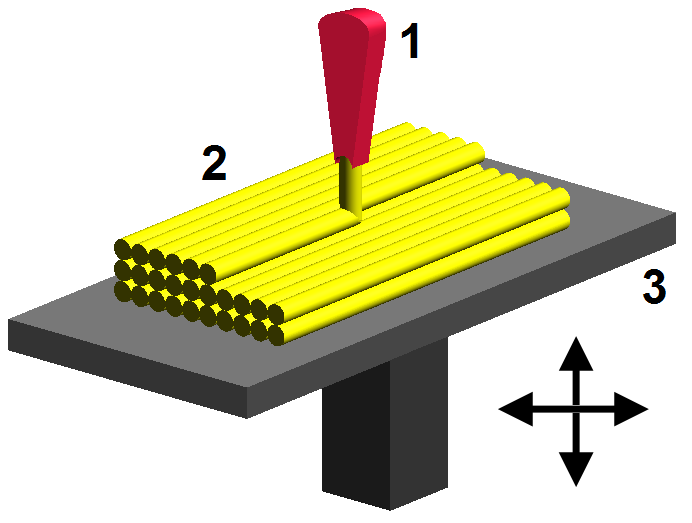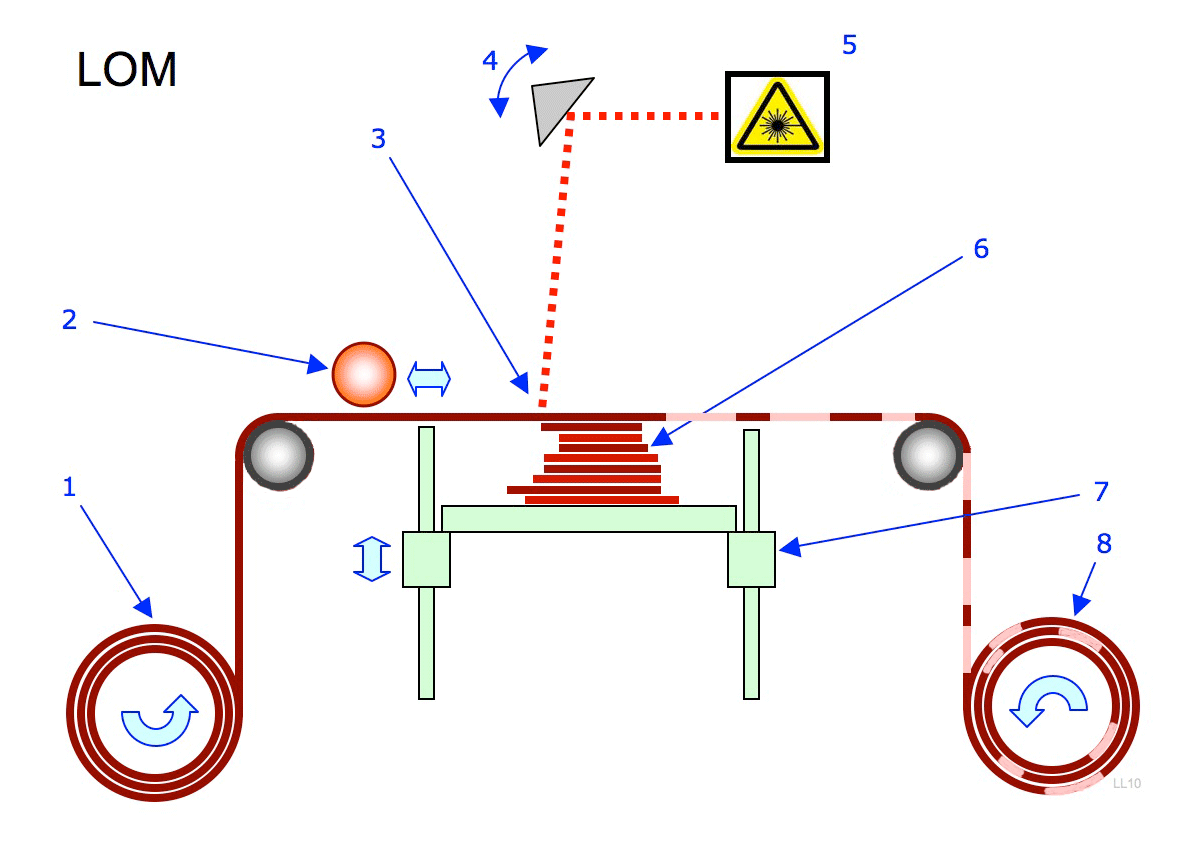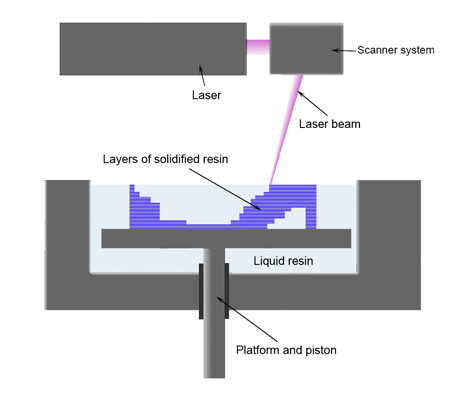Fused Deposition Modeling (FDM)
This technology works on an additive principle, products are build layer by layer. There are many friendly materials available for this method, including ABS, wax, and elastomer. FDM uses a heated extrusion tip to melt materials in filament from. The method is relatively fast, SLA and SLS are even faster though. An disadvantage is the required finishing, the layers are detectable and have to be finished for a better result. Also, the flexural strength is about the half of a molded part of the same shape. FDM is commonly used for prove of concept, and functional prototypes.
Laminated Object Manufacturing (LOM)
LOM is a technique where layers are laminated on top of each other. The layers are of adhesive-coated paper, plastic, or metal. They get glued together and cut to shape with a knife or laser cutter. Advantages are the low cost, due to cheap raw material. Relatively large parts can be made because there is no necessary chemical reaction. A con is the dimensional accuracy, which is not as good as with other rapid prototyping techniques. The most used material is paper, which needs the same finishing as wooden parts.
Open Hardware
Open Hardware has the same setup as Open Software, like the open source operating system Linux. People are free to use existing designs of hardware, containing lots of electronic parts. In stead of sharing the schematics, HDL code is shared. These descriptions are commonly used to set up system-on-a-chip systems. There are different licences which can be used. Most popular are the TAPR Open Hardware Licence, Balloon Open Hardware License, OpenCores, and Hardware Design Public License.
Stereolithography Apparatus (SLA)
Stereolithography is an additive manufacturing process. Here again, the product is build layer by layer. The machine contains a UV laser and a resin bath. The UV laser traces a pattern of a layer, exposure to the UV laser light solidifies the resin, and makes it adhere to the layer below. The 3D model is build and a final step is to clean the excess resin. This is done in a chemical bath. Finally the object is cured in a UV oven. The technology is mostly used early in the design process.
Selective Laser Sintering (SLS)
SLS is a rapid prototyping technique which uses sintering as it's main process. A CO2 laser fuses small particles of material together to create a layer of an object. When the layer is finished, the layer bed is lowered an another amount of powder is added on top. The laser fuses the next layer here again, repeating this till the product is completed. The exess powder needs to be removed, and some surface finishing may be needed. The layers have a thickness of about 0.15 mm. This process can create prototypes of huge dimensions. For example, total car dashboards can be manufactured.
Traditional Models
Traditional models are commonly made using one of the three main techniques, addition of materials, substraction of materials, or a mix between those two. Many materials can be used. Paperboard and paper are mostly used in architecture models, but they can be used for products very well too. Adventages are the costs and manipulability, though it's almost impossible to create curves. Paper is used very early in the design process. An other material which is used very often, is foam. There are many types of foam, differing in hardness. Foams are good for organic shapes, and they are fast and cheap. Wood is rigid, durable, and there are many types with different properties. Other possibilities are many types of resins, and laminating by hand.
References:
Images from wikipedia.org, Z-Printer image from caddyspain.com
Z-Printer
The Z-Printer builds the prototype by making many thin cross sections of the model. A printerhead moves around the layer to deposit liquid binding material. A thin layer of powder is spread on top of this layer, and the process repeats. The exess powder is automaticly removed by the machine. Main advantage of using this method is the possibility to add color to the product. This allows you to representate different materials held by the product.General Opinion
Using previous listed rapid prototyping techniques can give you big advantages during the design process. Especially when they are used early in the process, they can prevent errors. Thereby it prevents you from paying a lot of money to repair the error later in the process, because this relation between time and costs is almost exponential. Of course, using these techniques can cost you some money, especially when u use techniques like SLA, SLS, FDM, LOM, and the Z-Printer. However, these costs are negligible when you think of the money you are saving, due to the early detection of errors. Not only the technical aspects are benefits, also aesthetic point can be taken into account. The models are perfect for use in public exhibitions, or to show your operator what your ideas are. Physical interaction with products always gives us a better experience with the product, than just graphical images and explanations. Most of these techniques have become a standard prototype manufacturing process, but I think there is a lot more to come. There is still much improvement possible in this area, like I stated in my first post of this blog. Let's also not forget the 'simple' way of making prototypes, like with materials as paper and cardboard. Those materials give us the opportunity to create quick and cheap representations of the design. Like I said before, physical interaction lets you experience the product way more than just visual interaction. Sometimes you see the first sketches and prototypes of famous architects and designers, and they look so plain and straightforward, sometimes even childish. We shouldn't forget the easy ways early in the process. I would like to end with a sketch of the famous architect Frank Gehry, who designed buildings including the Guggenheim Museum, Walt Disney Concert Hall, Dancing House, and many more. You can see the simplicity of designing in his sketches. |
| Peter B. Lewis Library |
References:
Images from wikipedia.org, Z-Printer image from caddyspain.com





